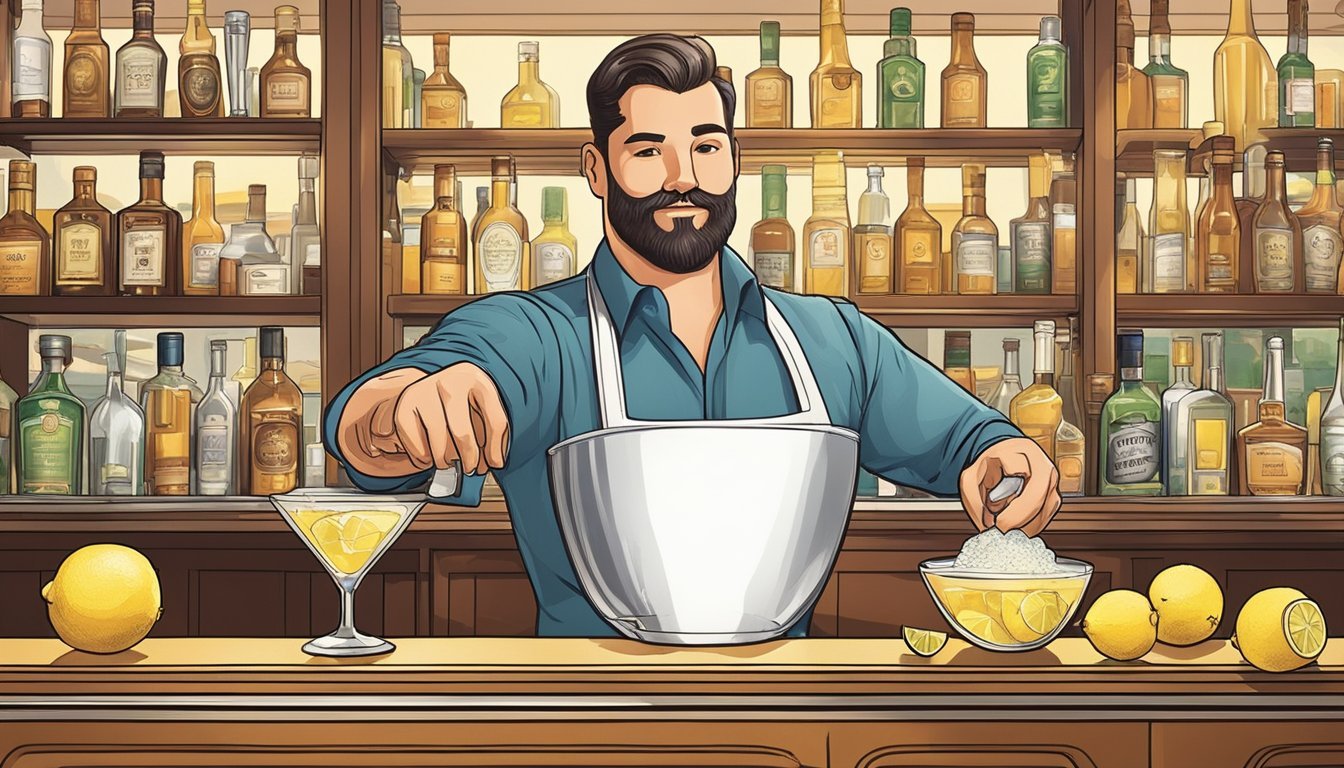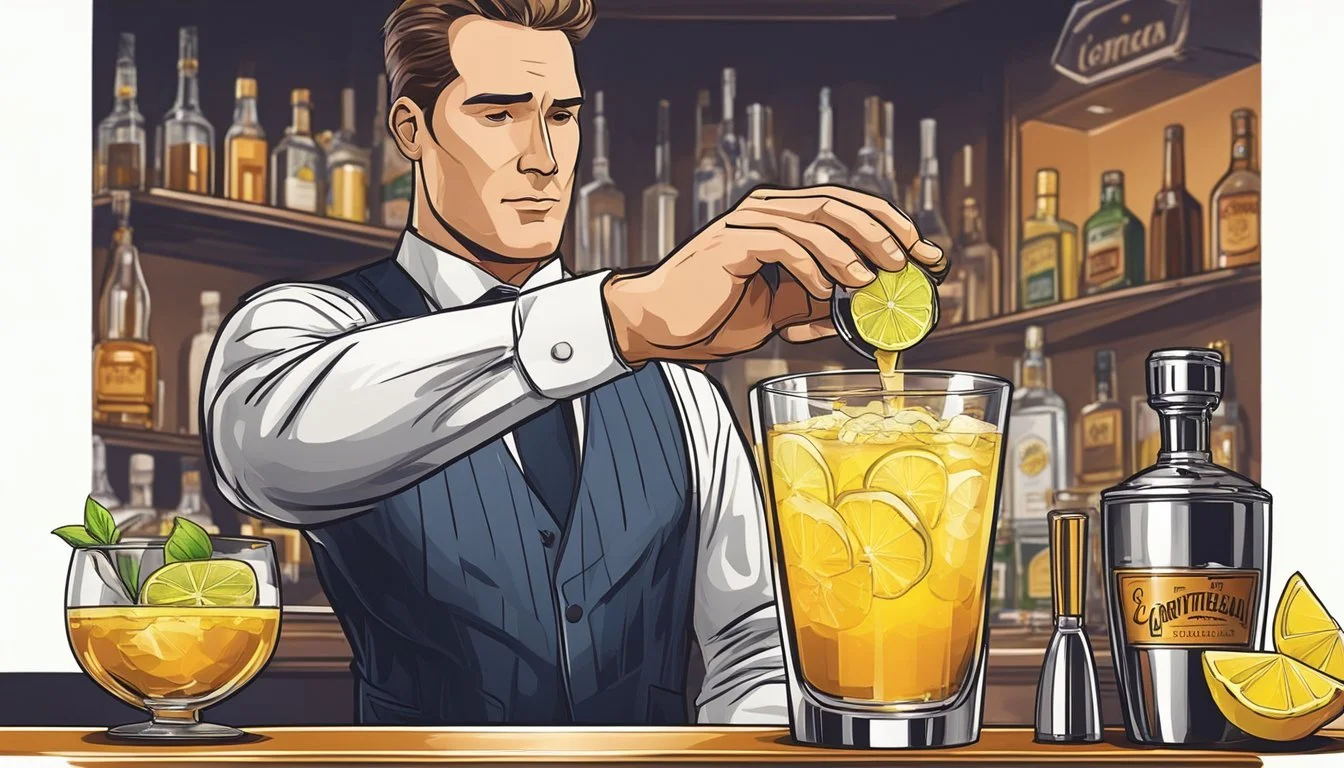Texas Bartenders' Guide to Mastering the Sidecar
Essential Tips for Crafting the Classic Cocktail
Texas bartenders have long been recognized for their versatile mixology skills and the ability to craft classic cocktails with finesse. The Sidecar is a testament to their expertise—a cocktail that requires a delicate balance of strong, sour, and sweet. This guide spotlights the precision and skill behind mastering the Sidecar, an enduring favorite that showcases the artistry found in Texas' renowned bars and restaurants. By understanding the traditional components and techniques required to execute this classic drink, bartenders across the Lone Star State can elevate their craft to new heights.
The Sidecar is a cocktail rooted in history, yet it continues to be a staple in the modern mixologist's repertoire. Perfecting this cocktail involves more than following a recipe—it is about understanding the interplay between its core ingredients: brandy or cognac, orange liqueur, and lemon juice. In Texas, where the cocktail culture is as rich and diverse as the state itself, bartenders are pushing the boundaries by introducing regional twists to this storied concoction.
This guide delves into the nuances of the Sidecar, from selecting the right kind of brandy to the importance of fresh citrus in achieving the signature tang. It's essential for Texas bartenders looking to master the Sidecar to appreciate the balance required for its assembly—ensuring that no single element overpowers another. With an eye for detail and a commitment to quality, Texas bartenders are well-positioned to carry on the legacy of the Sidecar, serving up a drink that's as timeless as it is tasteful.
History and Origin of the Sidecar
The Sidecar has European roots and is linked to the era of the First World War. Its evolution reflects the ingenuity of bartenders in Paris and New York, who adapted this iconic cocktail to suit their clientele's palates.
European Beginnings
The Sidecar cocktail was born in the early 20th century, with Paris often cited as its birthplace. It is believed to have been a variation of the Daisy cocktail—a family of drinks that combined a spirit, citrus juice, and a flavored sweetener. The Sidecar retained the basic structure but opted for a specific blend of cognac, orange liqueur, and lemon juice.
First World War Influence
The cocktail's name is frequently attributed to the practice of a motorcycle sidecar serving as a popular mode of transport for officers during the First World War. The actual connection between the mode of transportation and the drink remains anecdotal, yet the association underscores the era's influence on the cocktail's nomenclature and perception as a drink to be reckoned with.
French and American Adaptations
After its conception in Europe, the Sidecar gained international acclaim. In Paris, bartenders mastered the craft of balancing the sour elements with sweetness, while their counterparts in New York put their own twist on the recipe, making it a transatlantic favorite. The Sidecar established itself as a classic cocktail, enduring through the ages due to its simplicity and the elegance of its composition.
The Fundamentals of a Sidecar
In mastering the Sidecar, one must prioritize precision and respect for tradition. This cocktail’s enduring appeal is rooted in its simplicity and balance, where quality ingredients and accurate proportions are essential.
Key Ingredients
Cognac: The base spirit, traditionally a fine quality such as Pierre Ferrand 1840, is crucial for its smooth depth.
Orange Liqueur: A premium orange liqueur, like Pierre Ferrand Dry Curaçao, contributes to the necessary citrus-sweet profile.
Lemon Juice: Freshly squeezed lemon juice is non-negotiable for its zesty brightness.
Sugar: A slight sugar rim adds a delicate sweetness that complements the cocktail's acidity.
Traditional Glassware
Coupe Glass: The Sidecar is elegantly served in a chilled coupe glass, enhancing its vintage appeal.
Garnish: A meticulously cut lemon twist or an orange peel is the customary garnish, resting gracefully on the rim or dropped in.
The Art of Balancing Flavors
The Sidecar epitomizes a well-executed balance between the warmth of cognac, the sweetness and complexity of orange liqueur, and the crisp tartness of lemon juice. Crafting a Sidecar requires one to adhere to the classic recipe ratios while adjusting for the sweetness or tartness of individual ingredients.
Mastering the Technique
Precision and skill are essential when a bartender crafts a Sidecar. Mastery of mixing, pouring, and garnishing ensures the signature balance of this classic cocktail is achieved with every serve.
Mixing and Shaking Fundamentals
Essentials:
Cocktail Shaker: A must-have for a proper Sidecar mix
Ingredients: Quality matters—Pierre Ferrand or a similar high-grade cognac is recommended
A bartender begins the Sidecar by precisely measuring each ingredient. They fill the cocktail shaker with ice before adding the cognac, freshly squeezed lemon juice, and Cointreau. Instead of a simple syrup, an upgraded demerara syrup can be employed for depth. It is vital to shake the mix just enough to chill and dilute the drink without watering it down.
Achieving the Perfect Pour
Key Points:
Strain: Expel only the chilled, mixed liquid, leave the ice
Coupe glass: Strain the Sidecar into this vessel for traditional serving
Achieving the perfect pour is a dance of control and timing. After shaking, the bartender expertly strains the cocktail, leaving the ice behind, and smoothly pours a clear, crisp mixture into a chilled coupe. The temperature, texture, and translucence of the drink are as important as its taste; pouring ribbons of liquid into the glass ideally showcases all three.
Garnishing with Precision
Garnish Choices:
Orange Twist: Classic and aromatic
Lemon Wheel: Adds a citrusy flair
Garnishing is the final, delicate touch that a bartender applies. For the Sidecar, a thin slice of orange peel twisted over the drink adds essential oils and an elegant aroma. Alternatively, a neatly cut lemon wheel placed on the rim offers simple yet classy visual appeal. This attention to detail not only elevates the presentation but also enhances the first sips with a zesty freshness that complements the drink's richness.
Classic and Contemporary Variations
In Texas, bartenders add a unique twist to the classic Sidecar cocktail, incorporating local flavors and preferences. They've managed to maintain the integrity of the classic while venturing into new, innovative territory that complements the state's vibrant cocktail culture.
Texas Sidecar
The Texas Sidecar stands as a regional take on the traditional recipe. Here, the classic brandy is substituted with tequila, nodding to the state’s love for this Mexican spirit. Texas bartenders often prefer a high-quality, agave-forward tequila to provide a smoother, more nuanced base. The typical orange liqueur remains, frequently choosing Cointreau, and freshly squeezed lime juice is used instead of lemon to give it a Texas kick. The balance is achieved with a touch of simple syrup to the mix.
Ingredients:
Premium tequila
Cointreau
Fresh lime juice
Simple syrup
Other Citrus-Inspired Cocktails
Beyond the Sidecar, Texas bartenders are no strangers to other citrus-inspired classic cocktails. Citrus is a crucial component in mixology as it brings acidity and freshness to drinks. A popular example is the margarita, which also heavily features lime and tequila but differs in preparation and taste profile from the Sidecar. They also craft variations on classics like the daiquiri and the whiskey sour, matching the citrus to the spirit in a harmonious dance of flavors.
Citrus Variations:
Margarita: Tequila, lime juice, Cointreau, salt rim
Daiquiri: Rum, lime juice, simple syrup
Whiskey Sour: Whiskey, lemon juice, simple syrup
Innovative Sidecar Variations
In their pursuit of innovation, Texas bartenders have pushed the boundaries, creating innovative Sidecar variations. They experiment with different types of citrus, swapping in yuzu, blood orange, or bergamot for a distinctive profile. Some may even incorporate local ingredients like Texas grapefruit or infuse syrups with local herbs for an added layer of complexity. These variations reflect not only the versatility of the Sidecar but also the creativity thriving in Texas' cocktail scene.
Creative Twists:
Citrus Swap: Using yuzu or blood orange for a unique citrus note
Infused Syrups: Syrups infused with Texas herbs or peppers
Local Citrus: Incorporating Texas grapefruit for a regional flavor
Advanced Mixology Techniques
In the realm of advanced mixology, Texas bartenders are elevating the classic Sidecar by incorporating sophisticated techniques that enhance the cocktail's richness and depth.
Crafting Signature Sidecars
They select premium ingredients such as Pierre Ferrand cognac for its refined flavor profile. To create a signature Sidecar, bartenders often make their own demerara syrup, adding a toasty sweetness that complements the cognac’s complexity. Each element is measured with precision, ensuring a balance of flavor and strength in every glass.
Exploring Sweetness and Complexity
The Sidecar's sweetness can vary widely based on the choice of orange liqueur and any additional sweeteners. Texas bartenders explore this spectrum by experimenting with different brands and types of orange liqueurs. They may also adjust the sweetness by using:
Simple syrup for a straightforward sweetness.
Demerara syrup for a more complex, caramel-like flavor.
Infused syrups that could introduce hints of vanilla or spice.
Layering of Flavors
Layering flavors is an essential technique in a bartender’s skill set. For the Sidecar, this might involve:
Using citrus juices beyond traditional lemon, such as grapefruit or blood orange, for a nuanced tartness.
Incorporating bitters to add depth; a dash of orange bitters can elevate the cocktail's citrus notes.
Presenting the drink with a sugar rim, which not only adds texture but also a gradual sweetening effect as the drink is consumed.
By embracing these advanced mixology techniques, Texas bartenders craft Sidecars that are not just cocktails but an artistic expression of their skill and knowledge.
Building a Bartender's Repertoire
A bartender's skill in mixing a Sidecar is enhanced by careful selection of cognac and the ability to create variations on the classic cocktail, offering guests a curated experience.
Cognac Selection and Alternatives
Cognac serves as the foundational spirit of a traditional Sidecar, bringing a rich French heritage to the drink. VSOP (Very Superior Old Pale) cognac is often chosen for its matured balance of flavors. However, alternatives like other grades of brandy can be utilized, maintaining the profile while achieving a different price point or flavor complexity.
Multiplying Your Menu with Sidecar Twists
By introducing variations on the Sidecar, bartenders can expand their menu offerings. Substituting cognac with spirits traditionally used in cocktails such as daiquiris or margaritas can create a new dimension. For instance:
Daiquiri-styled Sidecar: Replace cognac with rum.
Margarita-styled Sidecar: Use tequila instead of cognac.
Each twist offers customers a familiar yet novel taste experience, similar to how a Cosmopolitan diversifies the use of cranberry juice.
Curating a Cocktail Experience
Creating a Sidecar doesn't end with recipes and spirits; it extends to crafting an experience. Understanding the nuances of the Sidecar allows bartenders to advise on pairings and educate patrons on the cocktail's history. The presentation of the drink, from glassware to garnishes, is equally crucial in conveying a sense of occasion and quality.
Sidecar in Contemporary Culture
The Sidecar cocktail has transcended its origins to become a symbol in various cultural domains, from high fashion to modern storytelling and media representation, reflecting its status as a refined drinking experience.
The Drink as a Fashion Statement
Fashion enthusiasts often embrace the Sidecar for its classic appeal, which aligns with timeless design principles. High-profile events and fashion shows have featured the Sidecar, where it is not only enjoyed as a beverage but also serves as an accessory to the luxe atmosphere. Grand Marnier, a key ingredient in the cocktail, has been associated with sophistication in several fashion campaigns, emphasizing the drink's worth as part of a stylish and curated lifestyle.
Literature and Art Influences
The Sidecar has been the subject of various written works by notable writers, who use the cocktail to evoke a sense of bygone elegance or to set the scene in narratives that span decadent eras. Museums like the Museum of the American Cocktail often illustrate the cocktail's history, showing its influence over time. The Sidecar's impact on art and literature exemplifies how a beverage can become a muse, inspiring creativity across a spectrum of artistic expressions.
The Sidecar in Modern Media
In film, television, and online content, the Sidecar frequently appears as the drink of choice for characters who embody refinement and worldliness. As travel shows and food documentaries explore global cuisine, the Sidecar is highlighted as a key element in the landscape of international drinks, reinforcing its place in a globally-aware beverage culture. Critics and connoisseurs discuss the Sidecar on platforms dedicated to wine and coffee, paralleling its complexity to these other beloved drinks. The portrayal in media often centers on the Sidecar as an emblem of cosmopolitan living and a testament to its enduring appeal.
Professional Guidance and Resources
Texas bartenders seeking to perfect the Sidecar cocktail can benefit from specialized training programs, historical insights, and a strong professional network. These resources can help bartenders enhance their craft, learn the legacy of classic cocktails, and stay connected with industry trends.
Training and Certification Programs
Texas Alcohol Beverage Commission (TABC) Certification is essential for bartenders operating in Texas. It ensures they are knowledgeable about legal responsibilities and safety. For mastering cocktails like the Texas Sidecar, mixology courses offered by professional training schools provide in-depth skills and techniques. These programs often include:
Hands-on practice with a cocktail shaker
The intricacies of Sidecar building
The use of a shim for balancing strong flavors
Books and Historical References
A foundational text is David Embury's "The Fine Art of Mixing Drinks", which offers clear explanations of mixology principles. For bartenders interested in the evolution of the Sidecar, references to historical texts and resources like the Museum of the American Cocktail can prove invaluable. Notable books include:
"Death & Co: Modern Classic Cocktails"
Bartending books rated highly on Goodreads and Amazon
These resources provide a solid historical background and a plethora of recipes that can lead to a deeper understanding of cocktail crafting.
Community and Networking
Engagement with bartender communities and networks is crucial. These platforms provide opportunities to discuss techniques like the methodical shaking or stirring of a Sidecar and the role of attachments such as motorcycle sidecars in thematic bartending. Points for networking include:
Online forums and social media groups
Local bartender meet-ups
Industry events where they can discuss the practical and historical aspects of three wheelers and Sidecars (both the drink and the vehicle)
Practical Considerations for Bartenders
Bartenders in Texas aiming to perfect the Sidecar cocktail must prioritize workflow, establish rapport with patrons, and sustain a safe bar environment. These elements are key to refining the drinking experience and ensuring a cocktail's reputation, much like the Sidecar, remains impeccable.
Workflow and Efficiency
In the fast-paced environment of a New York bar, bartenders must harness workflow and efficiency. They should organize their workstations with the most used spirits and tools within arm's reach. For instance, when crafting a Sidecar, citrus squeezers and jiggers should be readily available. Furthermore, bartenders should practice and perfect free-pouring to create pouring ribbons, reducing the time taken to serve each drink without compromising on precision.
Tools needed for a Sidecar:
Citrus squeezer
Jigger
Cocktail shaker
Strainer
Free-pouring techniques:
Count method for consistency
Use of timed pours for accuracy
Customer Interaction
Bartenders define the customer experience. In conversation, they must be attentive and personable, all the while exuding confidence in their mixology skills. They send and receive cues, akin to a dance, skillfully recommending drinks like the Sidecar to patrons seeking a refined drinking experience or introducing newcomers to the cocktail's storied legacy tied to New York's classic bar scene.
Keys to successful interaction:
Actively listen to the customer’s preferences
Provide suggestions without being overbearing
Showcase knowledge about drink histories and ingredients
Maintaining a Safe Environment
A bartender's role extends to being the lead on safety within their establishment. They are responsible for identifying signs of intoxication and managing such situations with tact. This may involve switching a patron to water or arranging transportation, all while ensuring PR disasters are avoided, potentially via discreet text messages to a manager or security personnel.
Safety checklist:
Look for signs of overconsumption
Have a discreet communication system in place
Prepare non-alcoholic options
Arrange safe transport, if applicable
In maintaining these practices, bartenders not only preserve the high standards of establishments such as those in Kawasaki but also contribute to their reputation as purveyors of quality and safety in the world of nightlife.
Conclusion
In their quest for refinement, Texas bartenders exhibit a deep appreciation for classic cocktails, and none embodies elegance like the Sidecar. This storied drink, a harmonious blend of spirit, citrus, and sweetener, presents itself as a pinnacle of a refined drinking experience. Ambitious bartenders across Texas have sought to master it, recognizing the cocktail's intricate balance and rich history.
The Sidecar is distilled simplicity: Cognac, lemon juice, and Cointreau or another orange liqueur. Yet, its simplicity belies the craft necessary to perfect it. Texas mixologists approach the Sidecar with respect, carefully measuring and mixing to ensure that the citrus does not overpower the Cognac's warmth, nor the sweetness muffle the spirit's depth.
Perfecting the Sidecar
Measure Carefully: Equal portions of lemon juice and Cointreau.
Balance Flavors: Tailor the sweetness to offset the lemon's tartness without diminishing the Cognac's presence.
Garnish Skillfully: A well-executed orange twist adds aroma and an extra layer of flavor.
They know that the success of a Sidecar hinges not just on the precision of the ingredients, but on the presentation and the ambiance it helps create. Texas bartenders encourage drinkers to savor the Sidecar slowly, appreciating the craftsmanship in every sip.
Aspiring bartenders in Texas see the Sidecar as more than just a cocktail; it's a testament to their dedication to the art of mixology. Through unwavering attention to detail and a commitment to quality ingredients, the Sidecar remains a timeless choice in the Texas bartending community.






